Revised 10 April 2022
Accepted 14 October 2022
Available Online 21 November 2022
- DOI
- https://doi.org/10.55060/s.atssh.221107.003
- Keywords
- Mural
Street art
Mass construction
Urban development strategy
Visual navigation
Contemporary city - Abstract
This article is devoted to the analysis of such a form of monumental art in the life of a modern city as muralism. The author highlights the spread of murals as one of the most striking and significant trends among the strategies of street art in the architectural and urban planning practice of the 21st century. Murals are considered as the most expressive positive way to enhance the imagery of a typical building, as well as an effective tool for urban improvement. Using concrete examples of Russian and international practice, the article illustrates the thesis that large-scale facade paintings facilitate navigation in the same type of environment and form the local identity of a particular place.
- Copyright
- © 2022 The Authors. Published by Athena International Publishing B.V.
- Open Access
- This is an open access article distributed under the CC BY-NC 4.0 license (https://creativecommons.org/licenses/by-nc/4.0/).
1. INTRODUCTION
Muralism as a notable direction of street art appeared in the 1990s and spread with incredible speed in different countries. The previous cultural and architectural background of the city, its size, and the level of its financial well-being turned out to be insignificant. Some researchers explain the wide popularity of muralism in the 21st century by the continuation of the line of decorative traditions of late modernism, others see this as an element of democratization and socialization of contemporary art in urban space, the thirds insist on the relative simplicity and cheapness of such a method of improvement of dysfunctional urban development. In any case, in a modern city the mural is the most notable form of street art present in public space.
In the architectural and urban planning practice of the 2000s and 2010s, murals (large-scale facade paintings and panels in various painting techniques) are increasingly being considered as an effective way to form an individual design of a particular place in a series of similar residential quarters. The presence of large painted panels on the walls of multistorey buildings, made by order or at least in agreement with the local administration, has become an everyday form of artistic play on the local identity of urban spaces in the 21st century. The geography of this phenomenon is constantly expanding, the artistic language is becoming more diverse, and the social orientation of such art within the framework of public art practices is easily integrated into the general paradigm of public demand for increased visualization of the environment of a modern citizen. The expectation of increased entertainment from the urban environment becomes a product of constant consumption, and the possibilities of media technologies only increase the impact of rapidly changing images and visual dominants [1].
Large-scale pictorial additions to the imagery of the facades of buildings in modern Russia and the countries of the former Soviet republics allow us to talk about certain parallels with the monumental facade compositions of architecture of late modernism, especially in the countries of the former USSR and the Socialist camps. Moving away from the visual reflections of the ideologies of socialism and communism of the twentieth century, new waves of artistic searches and reflection of a certain social context manifested themselves in the spread of street art and muralism practices as a new urban art of the 21st century (Fig. 1).
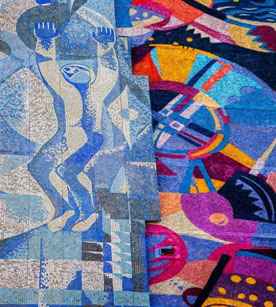
Mural on civil building in Almaty, Kazakhstan.
2. MURALS AS A PHENOMENON OF MODERN URBAN CULTURE
Since muralism as an artistic phenomenon is gaining popularity all over the world, murals are becoming not only a visual tool to enhance the aesthetic value of buildings, but they can be considered as an important element of introducing historical memory into the consciousness of young generations of citizens. Therefore, this kind of thematic muralism is especially in demand by city authorities in the cities of the former USSR and in countries that have been strongly influenced by Soviet ideology, since in the post-Soviet space it serves as a logical continuation of the line of the presence of monumental art on the facades of buildings of mass construction, characteristic of the architecture of late Soviet modernism.
Murals are encouraged by the authorities in the urban space of many European countries as a means to diversify a fragment of the environment and “entertain” citizens, which fits well into the global trend of the last two decades to give the appearance of the city more entertainment [2] and visual appeal. Muralism enhances the effect of theatrical scenery due to the differentiation of scales (a huge figure, a face with a residential building, as in the works of H. Baykirch or E. Cobra, an animal of several floors size, etc.) [3]. Games with scale in the images of really large urban spaces (the facades of multistorey buildings, firewalls, etc.) give the building an additional multidimensional perception, enhancing the effect of the game, theatrical impact on the viewer. At the same time, a certain specificity of the choice of the nature of the emerging images is revealed. Somewhere there are more entertaining and illusory murals, and somewhere on the contrary, military and social themes, national history and individual locally significant figures are especially in demand. At the same time, the most large-scale murals always form a trend for better interaction between the authorities, utilities and residents, since they turn out to be the most resonant in the public consciousness.
Patriotic and educational compositions of street art and thematic murals of similar content are often picked up by local amateurs. Sometimes the initiative comes from the residents themselves and urban enthusiasts are engaged in the tasks of promoting memorable events or important personalities. And their initiatives, as a rule, find a response from the authorities, since they serve the general promotion of individualization and popularization of a particular city, the formation of a local identity. Examples of such activist artists can be found in a variety of countries from China to Latin America.
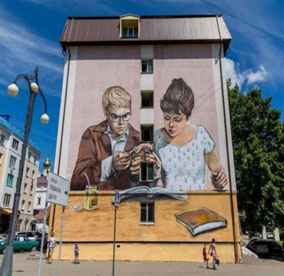
The movie characters of L. Gaidai's film near the Belgorod State University (2020).
Often local street art becomes a point of pride and attracts additional attention of tourists. Since 2013, large-scale street art festivals have been held by many Russian cities – the “Cultural Code” in Chelyabinsk [4], Yekaterinburg, Nizhny Novgorod, Kazan [5] and St. Petersburg. Their special works in the format of urban murals are very revered in Vyksa, Borovsk, Yelets, Kolomna, Syzran, and other small cities of Russia. Lipetsk artist Dmitry Savosta methodically creates portraits on the facades of buildings in honor of famous people or street names of the city, (in particular, cosmonauts Yu.Gagarin, V.Tereshkova, Marshal Nedelin), transforming along the way low-aesthetic elements of urban improvement or technical buildings (electrical substations, water towers, etc.) [6]. In Belgorod, since June 2021, residents themselves can order a mural on any topic on any house: from their favorite movie characters (Fig. 2) to fantastic abstractions.
The tasks of coordinating and organizing the process of performing the mural are assigned to city management companies, but the reason for creating an image may be the desire of most residents to give their home a unique and recognizable character. Legally, this is already possible and even encouraged by the city authorities. It is also very logical to colour dilapidated urban verticals with thematic murals. In the same Belgorod, by the Victory Day of 2022, it was decided to decorate six water towers with appropriate military-patriotic murals [7].
3. TYPES OF URBAN MURALS
Murals of the modern city demonstrate the techniques of traditional painting with a small percentage of digital technology (photo printing, video projection and subsequent fixation). The Muralism as a kind of street art uses almost all the techniques and methods inherent in this type of street art. One can find deceptive panels and full-scale illusions, images that complement the space and destroy it. Complementary murals work as an element of replacement of insufficient or absent landscaping (France, works by Patrick Commesi) [8] (Fig. 3) and as a separate artistic or purely colour accent in the existing building.
“Destructive” illusions create a deliberate effect of a curved, deformed space, enhancing the overall drama of a particular place. In particular, the artist Manuel di Rita became famous for such illusions [9]. Such effects are characteristic of some public art practices used to attract attention to a place or issue, less often to a problem, implemented through a specific artistic statement or action. In its figurative effect, the mechanism of “destructive” illusions of street art (Fig. 4) is very close to dramatic Baroque compositions that deformed the calm lines of order architecture or “splashed out” individual figures and objects beyond the graphic boundaries of the designated composition. (In particular, in large-scale murals of the ceilings of the interiors of state halls, etc.)
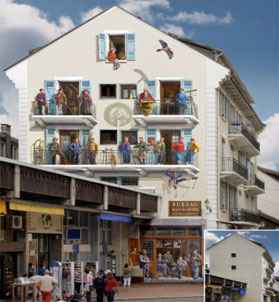
The illusion of “beautification” by Patrick Commesi (Lyon, France).
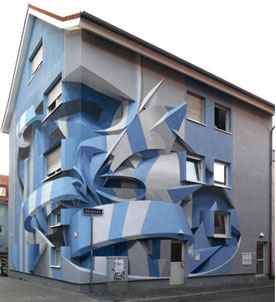
The “Deconstructivist Illusion” by Manuel di Rita (house in Mannheim, Germany).
To a somewhat lesser extent, lettering occurs in urban muralism, since it is very difficult to build a monumental composition the size of a house only in the technique of reproducing letter modifications of the image. All the more attention should be paid to the works of the Russian street art artist Pokras Lampas, who created a unique author's style (“calligraphiti”) on the basis of large-scale lettering [10]. By means of this author's style, the artist forms a new face of giant public spaces, squares and ends of multistorey buildings, placing visual accents in the already established urban environment. His artistic method is akin to the art of medieval Islamic artists who covered the impressive facades and interiors of mosques, madrassas, palaces and tombs of rulers with various ornaments (Fig. 5).
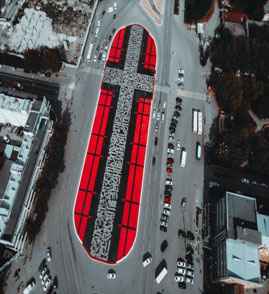
Design of the square in Yekaterinburg (Pokras Lampas, 2018).
4. STREET ART AND LOCAL AUTHORITY PRACTICES: RELATIONSHIP
Large-scale photo printing and the combination of various painting techniques are possible only if appropriate technical means are available. Therefore, muralism as a phenomenon cannot exist without a certain support of an administrative resource. The organization of lifts, etc. to perform the mural in the specified physical parameters automatically excludes the protest nature and rebellious spirit of the original street art practices. And here a field is being formed to search for mutual agreements about the appearance of their surroundings between the authorities, artists and residents of a particular place. Therefore, muralism should be regarded rather as a positive phenomenon of urban life, giving additional reasons to search for artistic and social compromises between various participants in urban processes.
The actual artistic quality of murals is not always so impressive that the townspeople want to preserve this art. But the relative cheapness and ease of its execution (compared with more traditional forms of architectural and artistic synthesis of arts) allows to change or alter not the most successful murals, and the potential short-life nature of such solutions causes fewer objections and opponents of such an approach to the coloring of fragments of urban development.
The success and rooting of street art and murals practices in the space of modern Russian cities lies not only in the attractiveness of the “free” self-expression of different artists with different artistic baggage in the space of modern architecture. It also does in the mechanisms of transformation of urban space, based on the synthesis of fine art, sculpture and architecture, close to a similar approach in the practice of Soviet architecture and urban planning in different periods of its development. The principles of transformation by painting large facade surfaces with clear concise frescoes and slogans were in demand during the formation of avant-garde and constructivism in the USSR, which in many ways turned out to be consonant with the techniques of modern muralism. Certain echoes of the use of artistic tools of agitation and ideological art were “rediscovered” in the protest segment of western street art of the late 1960s- early 1980s [11], and then returned to Russia as modern fashionable artistic practices at the turn of the 1990s-2000s.
Mosaics and reliefs on facades and in iconic interiors of public buildings and complexes of Soviet modernism were an essential part of the overall imagery of buildings of this period. The trend of synthesis of visual arts and architecture was organically integrated into the general aesthetics and ideology of its time. Frescoes, large-scale mosaics in parks and on facades of public buildings, which were often the main colour spot and artistic accent of large buildings of Soviet modernism, are very characteristic both for individual buildings and ensembles of the 1970s-1980s, and for the entire urban space of this period in the USSR. Giving an individual character to typical areas using unique thematic murals and mosaics was also used as a technique in Soviet urban planning in the 1970s-1980s. Therefore, it is quite obvious that thematic murals on the side facades of residential buildings should be considered as almost continuous artistic practice for the individualization of a new typical environment. And here the continuity of the past tradition with the new practice of creating large-scale murals is clearly traced, not only in the structure of mass residential development, but also in individual modernized industrial zones, former factory territories [12] transformed into business clusters, food courts, etc. Thus, the murals of the 21st century change the appearance of monotonous urban space, filled with typical buildings. In the spread of this practice, we observe a synthesis of monumental fine art and architecture, implemented in the conditions of urban space development that are new to the post-Soviet reality.
5. ARTISTIC PRACTICES OF STREET ART: ATTITUDE OF RESIDENTS
A specific feature of public art strategies in the new century is the short duration and finiteness of various actions in the space of a modern city. Muralism is a form of artistic development of large-scale fragments of buildings, located at the junction of social, utilitarian and purely artistic tasks of actual architectural practice. The facilitation of local orientation and practical navigation, presented in the form of non-repeating art panels, also reflect the practical tasks of creating elements of urban design. If desired, individual expressive deer can become the basis of the overall design code of a particular area or even a small city in order to distinguish it from comparable neighboring settlements.
Murals and large-scale fragments of street art in the structure of the urban picture find a significant response in the perception of residents of different countries, since this is an artistically designed and quite variable example of combining modern street art with a strategy approved by municipal authorities to increase expressiveness of the urban environment.
In recent years, the picturesque techniques of modern muralism have played a big role in facilitating navigation within the same type of buildings of mass development and giving large residential complexes additional individuality, which turns out to be an affordable technology for transforming the environment in cities with a wide variety of financial potentiality. As it was mentioned earlier, large-scale paintings on the facades of buildings are always a consistent format for the presence of art in urban space. Any temporary festivals of street art are the result of an agreement with the authorities. Often (before the pandemic), almost every such festival gathered significant international teams of artists formed within the framework of different cultural traditions. This creates a very diverse artistic environment in its figurative content in a limited area and effectively “assigns” a pronounced character to individual typical structures (Fig. 6).
This method contributes to a greater stylistic and artistic diversity of the transformed urban fragment, which often causes quite notable support from the citizens. Most of the authors of famous murals have a very wide geography of the execution of their plans. Therefore, it is obvious that many street-art artists work in a recognizable author's manner and successfully exploit certain themes or plots, performing variations of their ideas in different cities.
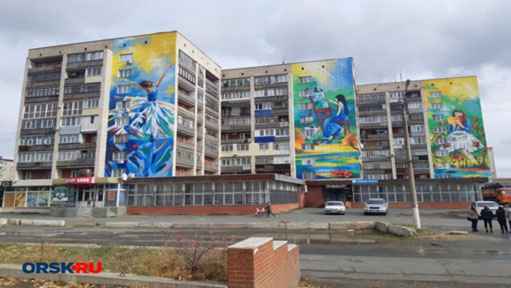
Murals in the residential development of Orsk, Russia (2020).
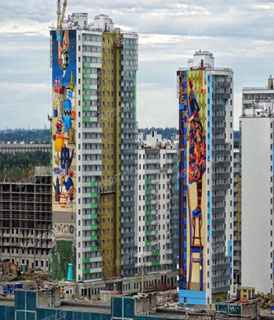
Murals on a typical building (Street Art Festival in St. Petersburg, Russia).
In modern Russian public practice, the mechanism for implementing the ideas of a street artist is a little simpler than in the late Soviet period. But sometimes it is not so easy to get approvals. And even more often, one-time street art actions are artistic statements of protest of a group of interested citizens and city activists. But this is by no means hooliganism, as in early graffiti (especially American) of the 1960s-1970s, but the result of a desire to decorate a house, yard, and neighborhood and transform an entire city. But if the chamber work of a street art artist is performed without proper prior approval, then his fate in the future is uncertain. In some cases, and not only in Russia, the lack of a proper legislative framework confuses both the city services and the artists themselves, who do not know who to negotiate with so that their work remains for a long time and is not destroyed. Currently, in many countries, there are precedents of a more positive attitude towards muralism and street art on the part of the authorities, and the programs of street art festivals are included in urban development programs, which is confirmed by the progress in local legislation.
The city is a concentration of people with different tastes and preferences, so there will always be residents defending their right to have their favorite murals, and people protesting against the presence of street art and graffiti in the urban space. A modern Russian city is a field for compromise and social interaction to a much greater extent than in the late Soviet period. The more valuable are the emerging mechanisms and individual techniques of artistic transformation of fragments of buildings and public spaces in the form of murals and street art. These time-limited examples of improving of the often dull appearance of urban architecture have a positive impact on the formation of the identity of a particular area or territory, and the use of various techniques and techniques of street art contribute to improving navigation in the structure of a typical mass development (Fig. 7).
6. CONCLUSION
Thematic murals on the side facades of residential buildings and public complexes of late modernism, present in cities today, can generally be considered as an almost continuous tradition for the individualization of a new typical development within the framework of the general cultural paradigm of artistic transformation of the urban environment of both the modernist city and the city space of the next digital era. In recent times, macro-scale work has become more accessible precisely due to the use of media and digital technologies for transferring and fixing images on the facade surfaces of buildings. Therefore, it is fair to conclude that the image of the urban space of the digital era is formed by the synthesis of fine art, media technologies and elements of traditional architecture, where muralism plays a key role as the most ambitious artistic strategy in urban space. The practice of creating large-scale murals integrated into mass residential development demonstrates modern approaches to the coexistence of traditional forms of art and architecture with new requirements to facilitate navigation in urban space and leads to greater individualization of a particular place. The city becomes more “own” and close to the residents, motivating them to become more involved in various aspects of urban life and to search for new ideas for further positive development.
REFERENCES
Cite This Article

TY - CONF AU - Marianna Maevskaya PY - 2022 DA - 2022/11/21 TI - Murals as a Key Form of Street Art in the Architecture of the City of the 21st Century BT - Proceedings of the 8th International Conference on Arts, Design and Contemporary Education (ICADCE 2022) PB - Athena Publishing SP - 5 EP - 11 SN - 2949-8937 UR - https://doi.org/10.55060/s.atssh.221107.003 DO - https://doi.org/10.55060/s.atssh.221107.003 ID - Maevskaya2022 ER -









